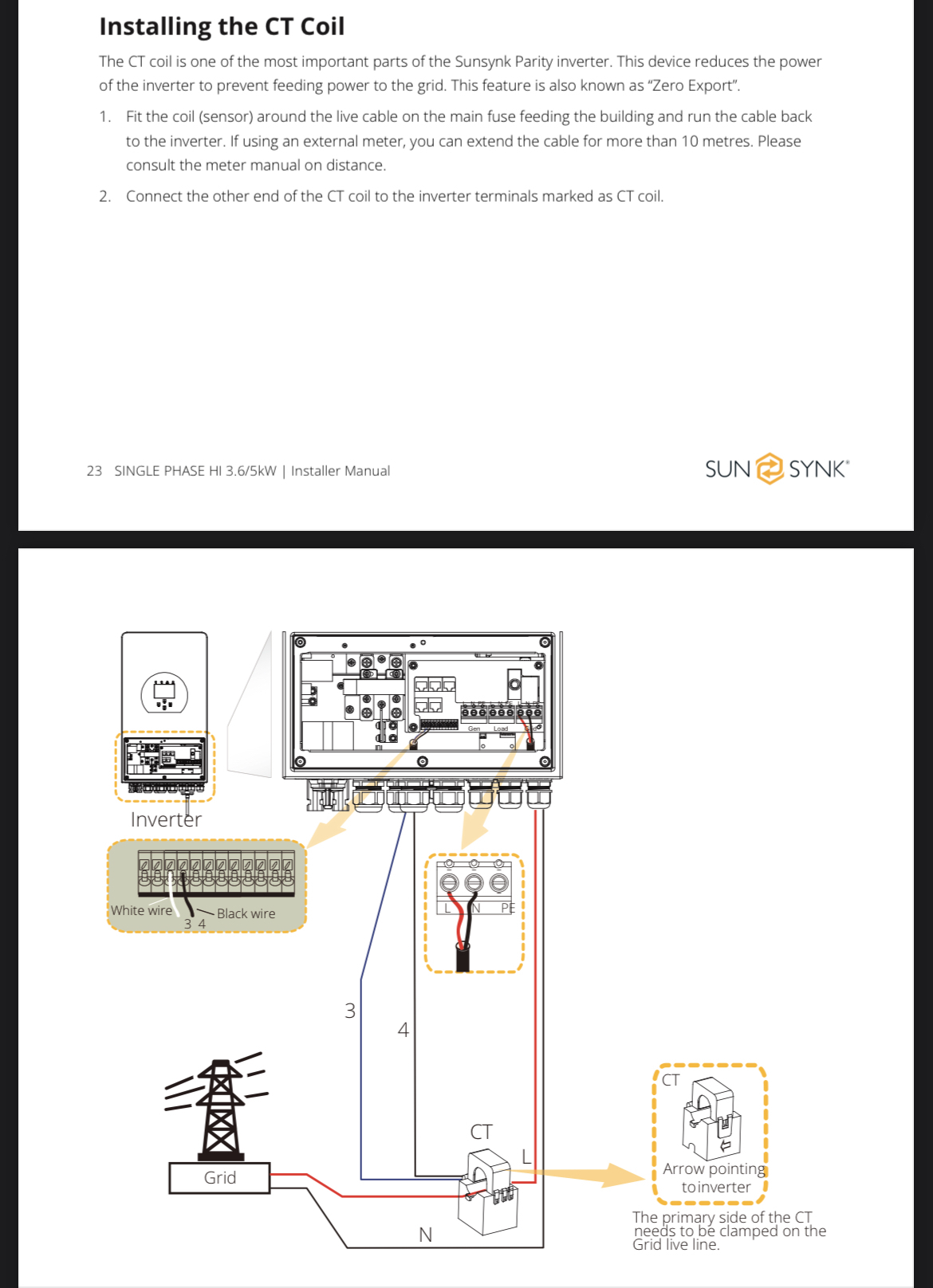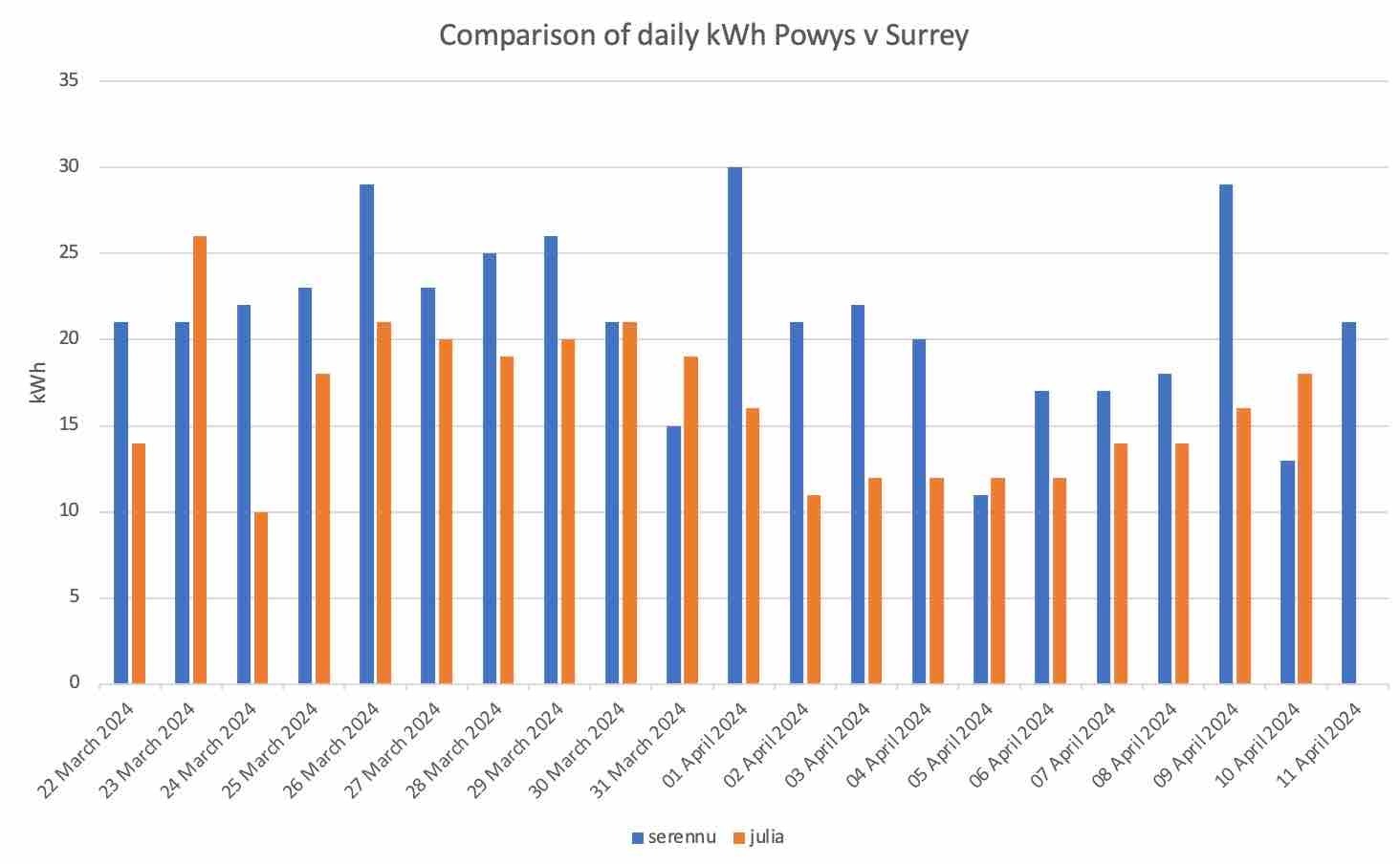Help, we have had air source heat pump fitted with solar panels and back up battery. This is our first winter with this new system and our electricity bills have tripled, we are afraid to turn the heating on. Our bill for the last 3 months is £1150 when it hasn’t been exceptionally cold. How can this be?
There should also be a web based monitor .. not sure if this was set up for you
There should also be a web based monitor .. not sure if this was set up for you
I can find something under the inverter that looks like that wifi thingy, it has a flashing red light on it but I can’t see anything that looks like a ct clamp. The only wifi that was set up was to connect the rads to the control hub which controls the temperature.
Yes the flashing red light sounds like a WiFi connection (although they’re often green when connected).
You should be able to set up an account either on the app or web to look at the inverter set up. This shouldn’t need much adjustment but it would show how things have been set up.
OK, so I have set up an account but the pages are blank, no information recorded
I can find something under the inverter that looks like that wifi thingy, it has a flashing red light on it but I can’t see anything that looks like a ct clamp. The only wifi that was set up was to connect the rads to the control hub which controls the temperature.
Yes the flashing red light sounds like a WiFi connection (although they’re often green when connected).
You should be able to set up an account either on the app or web to look at the inverter set up. This shouldn’t need much adjustment but it would show how things have been set up.
There should also be a web based monitor .. not sure if this was set up for you
There should also be a web based monitor .. not sure if this was set up for you
I can find something under the inverter that looks like that wifi thingy, it has a flashing red light on it but I can’t see anything that looks like a ct clamp. The only wifi that was set up was to connect the rads to the control hub which controls the temperature.
Yes the flashing red light sounds like a WiFi connection (although they’re often green when connected).
You should be able to set up an account either on the app or web to look at the inverter set up. This shouldn’t need much adjustment but it would show how things have been set up.
OK, so I have set up an account but the pages are blank, no information recorded
I can find something under the inverter that looks like that wifi thingy, it has a flashing red light on it but I can’t see anything that looks like a ct clamp. The only wifi that was set up was to connect the rads to the control hub which controls the temperature.
Yes the flashing red light sounds like a WiFi connection (although they’re often green when connected).
You should be able to set up an account either on the app or web to look at the inverter set up. This shouldn’t need much adjustment but it would show how things have been set up.
OK, so I have set up an account but the pages are blank, no information recorded
I don’t have this system exactly unfortunately but there are a series of videos which might help
I don’t have this system exactly unfortunately but there are a series of videos which might help
Thank you but doesn’t really help, I just don’t understand it.
Unfortunately it’s not a simple “press this button” system .. it can be difficult to explain everything, especially remotely.
The best route would be to have someone walk you through the whole system. The installer should have done that and because these things work in quite different ways to older technology, old ‘solutions’ (like turning off the radiators) doesn’t help.
We’ve asked for any other advice from others in case they can explain better.
The videos on the link above walk through the solar system but I understand they might not look straight forward
I’ve read a little more about the Sun Synk inverter and there should be a CT coil

The image shows where the CT should be, which is where the mains electricity enters the premises.
Here’s the manual although I realise it might not be simple to follow
Not to give you information overload I’ll come back tomorrow and suggest what you could look at regarding the heat pump.
I think you have a good system there, it just needs to be set up better, which will give you lower bills and a warmer house.
Not to give you information overload I’ll come back tomorrow and suggest what you could look at regarding the heat pump.
I think you have a good system there, it just needs to be set up better, which will give you lower bills and a warmer house.
Thank you juliamc, I will be grateful for any suggestions you might have.
Hi
Sorry, this is going to be a long message ! I’ve read up on a few things and hope to explain them here:
Heat pump size
Somewhere in your paperwork you should have a note of the heat loss for your property. That would determine the size of the heat pump installed. Mine is on a page headed MCS Compliance Certificate. On it is Design Information showing “design external temp” and “total building heat loss at design condition (kW)”.
For my 3 bed bungalow mine is 5.51 kW at -1.94 degC. I have a 6 kW heat pump, ie it produces 6 kW of heat at about -2 degC.
You said you have a Vaillant aroTHERM plus VWL 105 / 6 air source heat pump which is 10kW, suggesting your heat loss is considerable more than mine. It would be good to know your heat loss figure to check that your heat pump is the appropriate size.
Flow temperature and the influence of the weather
The same document shows the design flow temperature ie the radiator temperature at -2 degC. Mine is 50 degC. Generally the lower the flow temperature the more efficiently the heat pump runs, however the flow temperature has to be high enough to heat your rooms to balance out the heat loss. Running on a “Weather Curve” means the flow temperature is automatically lowered as the outside gets warmer, thus on milder days the efficiency is better. For example today it’s 12 degC here and my radiator temperature is 35 degC. The radiators are double panel mostly and at 35 degC they barely feel warm, but provide enough heat to get the rooms to 22 degC.
Getting the Weather Curve set correctly will give you the right flow temperature at any outside temperature.
Yield and COP
On your photo of the controller screen (the one with a block of 4 long buttons and the round reset button) the display shows 10,8 kWh/d. That number is what Vaillant call Yield, meaning (as I understand it) that when the photo was taken the heat pump had created 10.8 kWh of ‘energy’ since the start of the day.
You’ll hear a lot about COP, the Coefficient Of Performance. Just to be contrary Vaillant call this the “Working Figure” and you can look that up on the controller too.
I’ve copied this from a brilliant website called energy-stats uk https://energy-stats.uk/how-to-measure-vaillant-arotherm-cop/ where he explains how to get this on the screen:
So from the initial menu (press top left button) we want to dive into “Yield Indicator” where we can find the following: (press the + to scroll through the items)
- Working Figure: Month (Heating)
- Working Figure: Month (Domestic Hot Water)
- Working Figure: Total (Heating)
- Working Figure: Total (Domestic Hot Water)
All of these totals are cumulative for the time period stated.
Month being the current month and Total being since installation.
Ideally the Working Figure for heating should be at least 3.5, it’s likely to be less than that as your bills are so high, but there are several things we can address to improve it.
Heating v hot water
When the heat pump heats your hot water it heats to a much higher temperature than for the radiators, that means the COP or Working Figure for hot water will be low, possibly around 2.5. If you don’t use much hot water then heating it once a day is sufficient, also heating it to 50 degC is plenty. I’m afraid I don’t know how to set that but your installers should be able to change it from the 60 degC you mentioned previously. It can be heated once a week to 60 degC for a legionella disinfection but really that’s not necessary. There are many heat pump owners who don’t do this, it’s an unnecessary waste of electricity, and there’s less chance of scalding yourself if it’s kept to 50 degC.
Controlling the radiators - don’t !
Your heat pump doesn’t need any other controls to adjust the radiator temperatures in different rooms.
It will work most efficiently when the valves on all the radiators are open and the water flowing around them is allowed to move unrestricted. You mentioned previously that you have Honeywell controls to have different rooms heated for only a few hours in the day. These will be pushing up the bills. Also the heat pump uses most electricity when starting up, so constantly stopping and starting will be costly.
Although it sounds counterintuitive there is no benefit in turning off the heating in some rooms (unless you close down a whole wing of a mansion maybe!!). Each cold room will be drawing heat from the warmer rooms.
With the low flow temperatures your rooms will take longer to warm up, so it’s important not to let them cool down too much. In my house I have the day temperature set to 22 degC until 10pm, when I set it back to 21 degC. It heats the hot water at 2.30 am, then starts the heating again to 22 degC at 3.30am.
If you are hardier than me you could have the room temperature at 19 degC during the day and set back to 18 degC at night or even less ! To stop the Honeywell having an effect I understand you should set them to a high temperature so they never close and therefore they won’t restrict the flow. Just use the Weather Curve to set the appropriate flow temperature.
For more info on setting the weather curve see https://energy-stats.uk/vaillant-arotherm-weather-curve-information/
Summary!
So to summarise it would be useful to know your heat loss and design flow temperature, and determine if the heat pump is the correct size. Also checking the Working Figure (COP) to see how it’s performing. Only heat your hot water enough for your requirements, and heat every room in the house but at a lower temperature if that sounds extravagant.
Obviously I haven’t explained how to do this as I don’t know the controls, but when you get the installers back in, and when SevernWye visit, I hope you can explain what’s needed.
Please report back how you get on and we can improve this all for you.
Best of luck! Julia
Hi
Sorry, this is going to be a long message ! I’ve read up on a few things and hope to explain them here:
Heat pump size
Somewhere in your paperwork you should have a note of the heat loss for your property. That would determine the size of the heat pump installed. Mine is on a page headed MCS Compliance Certificate. On it is Design Information showing “design external temp” and “total building heat loss at design condition (kW)”.
For my 3 bed bungalow mine is 5.51 kW at -1.94 degC. I have a 6 kW heat pump, ie it produces 6 kW of heat at about -2 degC.
You said you have a Vaillant aroTHERM plus VWL 105 / 6 air source heat pump which is 10kW, suggesting your heat loss is considerable more than mine. It would be good to know your heat loss figure to check that your heat pump is the appropriate size.
Flow temperature and the influence of the weather
The same document shows the design flow temperature ie the radiator temperature at -2 degC. Mine is 50 degC. Generally the lower the flow temperature the more efficiently the heat pump runs, however the flow temperature has to be high enough to heat your rooms to balance out the heat loss. Running on a “Weather Curve” means the flow temperature is automatically lowered as the outside gets warmer, thus on milder days the efficiency is better. For example today it’s 12 degC here and my radiator temperature is 35 degC. The radiators are double panel mostly and at 35 degC they barely feel warm, but provide enough heat to get the rooms to 22 degC.
Getting the Weather Curve set correctly will give you the right flow temperature at any outside temperature.
Yield and COP
On your photo of the controller screen (the one with a block of 4 long buttons and the round reset button) the display shows 10,8 kWh/d. That number is what Vaillant call Yield, meaning (as I understand it) that when the photo was taken the heat pump had created 10.8 kWh of ‘energy’ since the start of the day.
You’ll hear a lot about COP, the Coefficient Of Performance. Just to be contrary Vaillant call this the “Working Figure” and you can look that up on the controller too.
I’ve copied this from a brilliant website called energy-stats uk https://energy-stats.uk/how-to-measure-vaillant-arotherm-cop/ where he explains how to get this on the screen:
So from the initial menu (press top left button) we want to dive into “Yield Indicator” where we can find the following: (press the + to scroll through the items)
- Working Figure: Month (Heating)
- Working Figure: Month (Domestic Hot Water)
- Working Figure: Total (Heating)
- Working Figure: Total (Domestic Hot Water)
All of these totals are cumulative for the time period stated.
Month being the current month and Total being since installation.
Ideally the Working Figure for heating should be at least 3.5, it’s likely to be less than that as your bills are so high, but there are several things we can address to improve it.
Heating v hot water
When the heat pump heats your hot water it heats to a much higher temperature than for the radiators, that means the COP or Working Figure for hot water will be low, possibly around 2.5. If you don’t use much hot water then heating it once a day is sufficient, also heating it to 50 degC is plenty. I’m afraid I don’t know how to set that but your installers should be able to change it from the 60 degC you mentioned previously. It can be heated once a week to 60 degC for a legionella disinfection but really that’s not necessary. There are many heat pump owners who don’t do this, it’s an unnecessary waste of electricity, and there’s less chance of scalding yourself if it’s kept to 50 degC.
Controlling the radiators - don’t !
Your heat pump doesn’t need any other controls to adjust the radiator temperatures in different rooms.
It will work most efficiently when the valves on all the radiators are open and the water flowing around them is allowed to move unrestricted. You mentioned previously that you have Honeywell controls to have different rooms heated for only a few hours in the day. These will be pushing up the bills. Also the heat pump uses most electricity when starting up, so constantly stopping and starting will be costly.
Although it sounds counterintuitive there is no benefit in turning off the heating in some rooms (unless you close down a whole wing of a mansion maybe!!). Each cold room will be drawing heat from the warmer rooms.
With the low flow temperatures your rooms will take longer to warm up, so it’s important not to let them cool down too much. In my house I have the day temperature set to 22 degC until 10pm, when I set it back to 21 degC. It heats the hot water at 2.30 am, then starts the heating again to 22 degC at 3.30am.
If you are hardier than me you could have the room temperature at 19 degC during the day and set back to 18 degC at night or even less ! To stop the Honeywell having an effect I understand you should set them to a high temperature so they never close and therefore they won’t restrict the flow. Just use the Weather Curve to set the appropriate flow temperature.
For more info on setting the weather curve see https://energy-stats.uk/vaillant-arotherm-weather-curve-information/
Thank you so much for all that, your kindness has reduced me to tears, I so appreciate you taking time to help me. It is a lot of information and I will work my way through it all. The lady from SevernWye is coming tomorrow and I will show her your suggestions. She admitted that she is not an expert on solar/HSAP but I am hoping that she can take away these suggestions and information to pass to someone in the organisation who knows more about it. I will let you know the outcome of the meeting tomorrow.It will take me a couple of days to work through all this info but I will get back to you asap.
Summary!
So to summarise it would be useful to know your heat loss and design flow temperature, and determine if the heat pump is the correct size. Also checking the Working Figure (COP) to see how it’s performing. Only heat your hot water enough for your requirements, and heat every room in the house but at a lower temperature if that sounds extravagant.
Obviously I haven’t explained how to do this as I don’t know the controls, but when you get the installers back in, and when SevernWye visit, I hope you can explain what’s needed.
Please report back how you get on and we can improve this all for you.
Best of luck! Julia
Hi
Sorry, this is going to be a long message ! I’ve read up on a few things and hope to explain them here:
Heat pump size
Somewhere in your paperwork you should have a note of the heat loss for your property. That would determine the size of the heat pump installed. Mine is on a page headed MCS Compliance Certificate. On it is Design Information showing “design external temp” and “total building heat loss at design condition (kW)”.
For my 3 bed bungalow mine is 5.51 kW at -1.94 degC. I have a 6 kW heat pump, ie it produces 6 kW of heat at about -2 degC.
You said you have a Vaillant aroTHERM plus VWL 105 / 6 air source heat pump which is 10kW, suggesting your heat loss is considerable more than mine. It would be good to know your heat loss figure to check that your heat pump is the appropriate size.
Flow temperature and the influence of the weather
The same document shows the design flow temperature ie the radiator temperature at -2 degC. Mine is 50 degC. Generally the lower the flow temperature the more efficiently the heat pump runs, however the flow temperature has to be high enough to heat your rooms to balance out the heat loss. Running on a “Weather Curve” means the flow temperature is automatically lowered as the outside gets warmer, thus on milder days the efficiency is better. For example today it’s 12 degC here and my radiator temperature is 35 degC. The radiators are double panel mostly and at 35 degC they barely feel warm, but provide enough heat to get the rooms to 22 degC.
Getting the Weather Curve set correctly will give you the right flow temperature at any outside temperature.
Yield and COP
On your photo of the controller screen (the one with a block of 4 long buttons and the round reset button) the display shows 10,8 kWh/d. That number is what Vaillant call Yield, meaning (as I understand it) that when the photo was taken the heat pump had created 10.8 kWh of ‘energy’ since the start of the day.
You’ll hear a lot about COP, the Coefficient Of Performance. Just to be contrary Vaillant call this the “Working Figure” and you can look that up on the controller too.
I’ve copied this from a brilliant website called energy-stats uk https://energy-stats.uk/how-to-measure-vaillant-arotherm-cop/ where he explains how to get this on the screen:
So from the initial menu (press top left button) we want to dive into “Yield Indicator” where we can find the following: (press the + to scroll through the items)
- Working Figure: Month (Heating)
- Working Figure: Month (Domestic Hot Water)
- Working Figure: Total (Heating)
- Working Figure: Total (Domestic Hot Water)
All of these totals are cumulative for the time period stated.
Month being the current month and Total being since installation.
Ideally the Working Figure for heating should be at least 3.5, it’s likely to be less than that as your bills are so high, but there are several things we can address to improve it.
Heating v hot water
When the heat pump heats your hot water it heats to a much higher temperature than for the radiators, that means the COP or Working Figure for hot water will be low, possibly around 2.5. If you don’t use much hot water then heating it once a day is sufficient, also heating it to 50 degC is plenty. I’m afraid I don’t know how to set that but your installers should be able to change it from the 60 degC you mentioned previously. It can be heated once a week to 60 degC for a legionella disinfection but really that’s not necessary. There are many heat pump owners who don’t do this, it’s an unnecessary waste of electricity, and there’s less chance of scalding yourself if it’s kept to 50 degC.
Controlling the radiators - don’t !
Your heat pump doesn’t need any other controls to adjust the radiator temperatures in different rooms.
It will work most efficiently when the valves on all the radiators are open and the water flowing around them is allowed to move unrestricted. You mentioned previously that you have Honeywell controls to have different rooms heated for only a few hours in the day. These will be pushing up the bills. Also the heat pump uses most electricity when starting up, so constantly stopping and starting will be costly.
Although it sounds counterintuitive there is no benefit in turning off the heating in some rooms (unless you close down a whole wing of a mansion maybe!!). Each cold room will be drawing heat from the warmer rooms.
With the low flow temperatures your rooms will take longer to warm up, so it’s important not to let them cool down too much. In my house I have the day temperature set to 22 degC until 10pm, when I set it back to 21 degC. It heats the hot water at 2.30 am, then starts the heating again to 22 degC at 3.30am.
If you are hardier than me you could have the room temperature at 19 degC during the day and set back to 18 degC at night or even less ! To stop the Honeywell having an effect I understand you should set them to a high temperature so they never close and therefore they won’t restrict the flow. Just use the Weather Curve to set the appropriate flow temperature.
For more info on setting the weather curve see https://energy-stats.uk/vaillant-arotherm-weather-curve-information/
Thank you so much for all that, your kindness has reduced me to tears, I so appreciate you taking time to help me. It is a lot of information and I will work my way through it all. The lady from SevernWye is coming tomorrow and I will show her your suggestions. She admitted that she is not an expert on solar/HSAP but I am hoping that she can take away these suggestions and information to pass to someone in the organisation who knows more about it. I will let you know the outcome of the meeting tomorrow.It will take me a couple of days to work through all this info but I will get back to you asap.
Summary!
So to summarise it would be useful to know your heat loss and design flow temperature, and determine if the heat pump is the correct size. Also checking the Working Figure (COP) to see how it’s performing. Only heat your hot water enough for your requirements, and heat every room in the house but at a lower temperature if that sounds extravagant.
Obviously I haven’t explained how to do this as I don’t know the controls, but when you get the installers back in, and when SevernWye visit, I hope you can explain what’s needed.
Please report back how you get on and we can improve this all for you.
Best of luck! Julia
Thank you so much for all that, your kindness has reduced me to tears, I so appreciate you taking time to help me. It is a lot of information and I will work my way through it all. The lady from SevernWye is coming tomorrow and I will show her your suggestions. She admitted that she is not an expert on solar/HSAP but I am hoping that she can take away these suggestions and information to pass to someone in the organisation who knows more about it. I will let you know the outcome of the meeting tomorrow.It will take me a couple of days to work through all this info but I will get back to you asap.
You are very welcome!! I hate to think your setup isn’t performing for you as it’s a very good machine.
I’ll let you get on with your homework now 😊.
Hi
Sorry, this is going to be a long message ! I’ve read up on a few things and hope to explain them here:
Heat pump size
Somewhere in your paperwork you should have a note of the heat loss for your property. That would determine the size of the heat pump installed. Mine is on a page headed MCS Compliance Certificate. On it is Design Information showing “design external temp” and “total building heat loss at design condition (kW)”.
For my 3 bed bungalow mine is 5.51 kW at -1.94 degC. I have a 6 kW heat pump, ie it produces 6 kW of heat at about -2 degC.
You said you have a Vaillant aroTHERM plus VWL 105 / 6 air source heat pump which is 10kW, suggesting your heat loss is considerable more than mine. It would be good to know your heat loss figure to check that your heat pump is the appropriate size.
Flow temperature and the influence of the weather
The same document shows the design flow temperature ie the radiator temperature at -2 degC. Mine is 50 degC. Generally the lower the flow temperature the more efficiently the heat pump runs, however the flow temperature has to be high enough to heat your rooms to balance out the heat loss. Running on a “Weather Curve” means the flow temperature is automatically lowered as the outside gets warmer, thus on milder days the efficiency is better. For example today it’s 12 degC here and my radiator temperature is 35 degC. The radiators are double panel mostly and at 35 degC they barely feel warm, but provide enough heat to get the rooms to 22 degC.
Getting the Weather Curve set correctly will give you the right flow temperature at any outside temperature.
Yield and COP
On your photo of the controller screen (the one with a block of 4 long buttons and the round reset button) the display shows 10,8 kWh/d. That number is what Vaillant call Yield, meaning (as I understand it) that when the photo was taken the heat pump had created 10.8 kWh of ‘energy’ since the start of the day.
You’ll hear a lot about COP, the Coefficient Of Performance. Just to be contrary Vaillant call this the “Working Figure” and you can look that up on the controller too.
I’ve copied this from a brilliant website called energy-stats uk https://energy-stats.uk/how-to-measure-vaillant-arotherm-cop/ where he explains how to get this on the screen:
So from the initial menu (press top left button) we want to dive into “Yield Indicator” where we can find the following: (press the + to scroll through the items)
- Working Figure: Month (Heating)
- Working Figure: Month (Domestic Hot Water)
- Working Figure: Total (Heating)
- Working Figure: Total (Domestic Hot Water)
All of these totals are cumulative for the time period stated.
Month being the current month and Total being since installation.
Ideally the Working Figure for heating should be at least 3.5, it’s likely to be less than that as your bills are so high, but there are several things we can address to improve it.
Heating v hot water
When the heat pump heats your hot water it heats to a much higher temperature than for the radiators, that means the COP or Working Figure for hot water will be low, possibly around 2.5. If you don’t use much hot water then heating it once a day is sufficient, also heating it to 50 degC is plenty. I’m afraid I don’t know how to set that but your installers should be able to change it from the 60 degC you mentioned previously. It can be heated once a week to 60 degC for a legionella disinfection but really that’s not necessary. There are many heat pump owners who don’t do this, it’s an unnecessary waste of electricity, and there’s less chance of scalding yourself if it’s kept to 50 degC.
Controlling the radiators - don’t !
Your heat pump doesn’t need any other controls to adjust the radiator temperatures in different rooms.
It will work most efficiently when the valves on all the radiators are open and the water flowing around them is allowed to move unrestricted. You mentioned previously that you have Honeywell controls to have different rooms heated for only a few hours in the day. These will be pushing up the bills. Also the heat pump uses most electricity when starting up, so constantly stopping and starting will be costly.
Although it sounds counterintuitive there is no benefit in turning off the heating in some rooms (unless you close down a whole wing of a mansion maybe!!). Each cold room will be drawing heat from the warmer rooms.
With the low flow temperatures your rooms will take longer to warm up, so it’s important not to let them cool down too much. In my house I have the day temperature set to 22 degC until 10pm, when I set it back to 21 degC. It heats the hot water at 2.30 am, then starts the heating again to 22 degC at 3.30am.
If you are hardier than me you could have the room temperature at 19 degC during the day and set back to 18 degC at night or even less ! To stop the Honeywell having an effect I understand you should set them to a high temperature so they never close and therefore they won’t restrict the flow. Just use the Weather Curve to set the appropriate flow temperature.
For more info on setting the weather curve see https://energy-stats.uk/vaillant-arotherm-weather-curve-information/
Thank you so much for all that, your kindness has reduced me to tears, I so appreciate you taking time to help me. It is a lot of information and I will work my way through it all. The lady from SevernWye is coming tomorrow and I will show her your suggestions. She admitted that she is not an expert on solar/HSAP but I am hoping that she can take away these suggestions and information to pass to someone in the organisation who knows more about it. I will let you know the outcome of the meeting tomorrow.It will take me a couple of days to work through all this info but I will get back to you asap.
Summary!
So to summarise it would be useful to know your heat loss and design flow temperature, and determine if the heat pump is the correct size. Also checking the Working Figure (COP) to see how it’s performing. Only heat your hot water enough for your requirements, and heat every room in the house but at a lower temperature if that sounds extravagant.
Obviously I haven’t explained how to do this as I don’t know the controls, but when you get the installers back in, and when SevernWye visit, I hope you can explain what’s needed.
Please report back how you get on and we can improve this all for you.
Best of luck! Julia
Hi Julia
An update on what has happened so far. Yesterday I turned the water down to 55, I took a meter reading today and we used 13kw less yesterday so today I have turned the water down to 50. I will take another reading tomorrow. The lady from SevernWye so totally, bloody useless. I told her I had turned the water down and she said ‘no,no you will get legionaires, you must keep it at 60. I nearly showed her the door then, she was clueless, so much for an energy advisor. She said it is wrong to turn on the heating and keep it running and couldn’t understand when I told her this is a completely different sort of heating system. She wasted an hour of my time when I could have been doing my homework. So tomorrow, am going to turn the heating on at between 18-20 and turn it down to about 15-16 overnight, does that sound ok to you? We have 9 rads so do you think I should have them all running? I am going through all the paperwork to find the info at the moment (a lot of paperwork). I also emailed Warm Wales as they are running this heating scheme and they recommended SevernWye to tell them how useless SevernWye are and they are going to contact the installers about this, so hopefully there will be some movement there. So that is what I have done so far, now going to click the link To Vaillant website you gave me. More updates to follow, thank you so much Julia.
Thank you so much for all that, your kindness has reduced me to tears, I so appreciate you taking time to help me. It is a lot of information and I will work my way through it all. The lady from SevernWye is coming tomorrow and I will show her your suggestions. She admitted that she is not an expert on solar/HSAP but I am hoping that she can take away these suggestions and information to pass to someone in the organisation who knows more about it. I will let you know the outcome of the meeting tomorrow.It will take me a couple of days to work through all this info but I will get back to you asap.
That is disappointing about the SevernWye lady, but not really surprising as heat pumps do seem to be a dark art compared to ‘normal’ high temperature heating that we’ve all been used to. They need to get up to speed if they’re going to give energy advice nowadays !!
You certainly don’t need to have the hot water at 60 degC all the time. Stick to 50 - even the cautious only heat to 60 once a week.
I think for now there’s nothing to lose by having it at 18-20 as you propose, and setting back overnight. As it’s quite mild at the moment it shouldn’t send the electricity use through the roof, and it would be useful to see that all 9 radiators are working ok.
How are you setting that temperature ? is it with the radiator valves or on the Vaillant controller ?
Yes sure Julia, I started on 21/03/24 when we got that huge bill
21/03 60899
24/03 60963
25/03 60986
26/03 61015
27/03 61038
28/03 61063
29/03 61089
30/03 61110
31/03 61125
01/04 61155
02/04 61176
03/04 61198
04/04 61218
05/04 61229
06/04 61246
07/04 61263
08/04 61281
09/04 61310
10/04 61323
11/04 61344
I have turned the heating on today, all rads are set at 18 in the day and 15 through the night. The reading tomorrow will be interesting.
Thanks. You probably have had enough with tech at the moment but if you had a smart meter it could give half hourly readings automatically. That really helps to see what’s going on…
Thanks. You probably have had enough with tech at the moment but if you had a smart meter it could give half hourly readings automatically. That really helps to see what’s going on…
We can’t have a smart meter here, too rural and very poor signal hence no mobile phones. I think you are right about leaving the heating on, I have noticed there hasn’t been the noise of the rad heating up in the lounge and house is nice and warm. As I said tomorrows reading will be very interesting
Ah. Shame about the meter but good that the heating’s on. As it’s mild now it shouldn’t be too expensive to try this. I think heating the hot water to 60 might have been pushing the bills up. It’s best not to change too many things in one go. I’m going to do a graph with your electricity v mine… back later.
Ah. Shame about the meter but good that the heating’s on. As it’s mild now it shouldn’t be too expensive to try this. I think heating the hot water to 60 might have been pushing the bills up. It’s best not to change too many things in one go. I’m going to do a graph with your electricity v mine… back later.
There is no consistency in those figures is there Julia? Huge relief tonight though, had a phone call from the Damien one of the installers. He told me to go with the changes I’ve made for a week. I am to ring him next week and if I am still not happy someone will come out to me. Can’t ask for more than that.

Here’s a comparison with my electricity use for the same period.
For us it’ll be mostly the heat pump; we also have a small electric heater going in the garage for a “short time”, an electric towel rail on occasionally, the usual kitchen things though rarely the oven recently. I had the heating on all night as a test until 28th March. Also I think the reading of 10kWh on 24th March is wrong - too low ! We were away 2nd - 4th April.
The air temperature has a noticeable effect on the amount electricity the hp uses, eg on the night of 23rd March it dropped to 5 degC and I had the heating running then.
So generally my use is less than yours, and I have the house at 22 degC. Yours ought to be lower too because your solar and battery should be giving you “free” electricity. That’s definitely something to question with the installers.
Good news that they’re able to send someone out.

Here’s a comparison with my electricity use for the same period.
For us it’ll be mostly the heat pump; we also have a small electric heater going in the garage for a “short time”, an electric towel rail on occasionally, the usual kitchen things though rarely the oven recently. I had the heating on all night as a test until 28th March. Also I think the reading of 10kWh on 24th March is wrong - too low ! We were away 2nd - 4th April.
The air temperature has a noticeable effect on the amount electricity the hp uses, eg on the night of 23rd March it dropped to 5 degC and I had the heating running then.
So generally my use is less than yours, and I have the house at 22 degC. Yours ought to be lower too because your solar and battery should be giving you “free” electricity. That’s definitely something to question with the installers.
Good news that they’re able to send someone out.
Gosh, that graph is so interesting Julia, we have been using a lot more energy than you. I spoke to the installer yesterday and told him I had turned all the rads on to 18 in the day and 15 through the night. He told me to lower it through the night as that is the time it is costing me so I lowered it to 12. Interestingly we used 2 kw yesterday day time with all those rads on but the reading this morning said we had used 12kw in total so 10 kw were used through the night. The house was much warmer but not quite warm enough so today I have turned the heating up to 21 and up till now (6.30 pm) we have used 2kw. I am happy with this as it works out having a warmer house for about £3 a day. I am going with this for a week or so but I think I will ask the installer to come as I have so many questions for them. It has definitely helped turning all the rads on as you suggested but because we are solar it isn’t as cheap for us to run them through the night as it is for you. I will see if turning them off at night will make a difference so that we only use 2kw all day. I have learned so much this last couple of weeks and it is all thanks to you, I’m very grateful.
Hmm. Not sure I agree that the heating would cost that much through the night. How are you controlling the times and temperature?
Hmm. Not sure I agree that the heating would cost that much through the night. How are you controlling the times and temperature?
I I have a wifi hub that controls the temps in each room
Reply
Log in to the OVO Forum
No account yet? Create an account
Enter your username or e-mail address. We'll send you an e-mail with instructions to reset your password.








